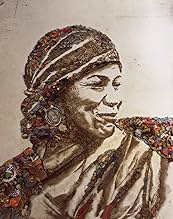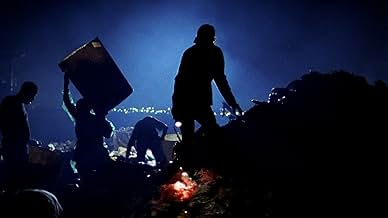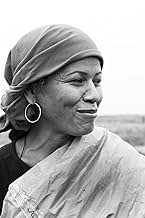Nos arredores do Rio de Janeiro fica o Jardim Gramacho, o maior aterro sanitário do mundo, onde homens e mulheres peneiram o lixo para sobreviver. O artista Vik Muniz produz retratos dos tra... Ler tudoNos arredores do Rio de Janeiro fica o Jardim Gramacho, o maior aterro sanitário do mundo, onde homens e mulheres peneiram o lixo para sobreviver. O artista Vik Muniz produz retratos dos trabalhadores e aprende sobre suas vidas.Nos arredores do Rio de Janeiro fica o Jardim Gramacho, o maior aterro sanitário do mundo, onde homens e mulheres peneiram o lixo para sobreviver. O artista Vik Muniz produz retratos dos trabalhadores e aprende sobre suas vidas.
- Direção
- Artista
- Indicado a 1 Oscar
- 29 vitórias e 13 indicações no total
Avaliações em destaque
The catadores, who number in the thousands, work under burning hot sun and overpowering odors collecting and selling recyclable materials such as bottles, plastic, and metal to wholesalers and middlemen who turn them into such resalable items as buckets or bumpers for automobiles. Vic Muniz' plan is to select and paint a group of six catadores to pose as photographic subjects that will mimic such classic paintings as "The Death of Marat" by Jacques-Louis David. Money from sales of the resulting art will go to the pickers association for the benefit of the workers. The project included Tiao, the leader of ACAMJG (Association of Collectors of the Metropolitan Landfill of Jardim Gramacho) who went on a hunger strike to dramatize the conditions of the pickers and built an organization that helped create a skills-training center and a medical clinic for the workers.
There was also Zumbi, a member of the association, who began a library from his home from books that had been discarded, Irma, a cook who makes stews and roasts from edible meat to feed the workers, Suelem, an 18-year old girl who has been working in the garbage dump since she was only seven years old, and Valter, an elderly man who entertains with stories and songs and who decides to participate because he believes that "it will raise awareness of all us pickers." Once the initial photographs are made, Muniz projects an enlarged version of each photo onto the floor of his studio and hires the pickers to add refuse from the landfill onto the canvas, photographing the result from overhead. This then becomes the finished art work, ready to be exhibited at auctions and museums around the world with the pickers traveling to such cities as London and New York, the first time they have ever left Gramacho.
Waste Land is not only a biography of an artist, but a look at the artist in the context of the community in which his art is created. Muniz reveals the courage and resilience of the people in spite of their grinding poverty and depressing environment. Many are former middle class residents of the suburbs who chose the life of the picker rather than becoming prostitutes or drug dealers and are happy with their choice. Though Muniz's goal was, "to be able to change the lives of a group of people with the same material that they deal with every day," he never dreamed that his work would impact the lives of the people so dramatically.
Through his efforts, many of the residents who worked for him have changed their life and either reconciled with their families or gone on to more rewarding jobs. Modernization has also begun to take shape at Gramacho. A recycling plant has been built and the workers have been separated into categories for more efficient organization. Though admittedly just a beginning, Muniz has demonstrated that the power of art is available to all people regardless of their circumstances, allowing them to experience their inner beauty and believe in themselves in a new way. Not succumbing to the temptations of melodramatic excess, Waste Land has been shortlisted for an Oscar for Best Documentary and fully deserves to be among the finalists.
The great idea of the documentary directed by Lucy Walker is to describe the process of creation in which the subjects are the Brazilian garbage pickers, called 'catadores' while the matter is the recyclable materials extracted from the huge garbage ground called 'Jardim Gramacho', which gathers most of the waste of the huge metropolis of Rio de Janeiro. However this is only the inner circle of this smart film, as the first part describes the search that triggers the project in which the artist explores the space of the big garbage dump. At first it looks like one of its work, a square on the map, getting closer men seem to be visible at the dimensions of ants, then zooming in we discover a full human landscape composed of people who may be working physically in garbage but they do it with pride and dignity and a sense of purpose of their work and its benefits for the overall good of the community. The human dimensions of the characters discovered by Muniz are best material on which relies the quality of his art and the quality of the film director Walker made about the process of creating his art.
'Waste Land' is beautifully filmed, the characters are well chosen, and one can say that garbage never looked so beautiful and full of colors and the garbage people never looked so clean and sexy as in this film. There is one more ethical question that needs to be asked about the realization of this documentary. By picking a few of the people of 'Jardim Gramacho' and making them for a few months part of the artistic creation process, Muniz, Walker and their teams took them out of the social medium they were living in and exposed them not only to art, to better work conditions, but also to the broader world living at a very different pace, social relations and living standards. Even as the money raised from the selling of the works returned to the people involved and to the social activities in the 'garbage garden' I could not ask whether the human involved will be able to get back to their previous work, or even as they use some of the cash earned for the participation in the project will they be able to overcome the short glimpse they witnessed of the world of glamor of art trade? Although Walker's documentary tried to give a rather positive answer to this question I could not avoid a slight suspicion of manipulation, or at least of a self-righteous perspective of the facts as they were presented. But maybe I am just over-concerned, or maybe Muniz and Walker are right in their approach, and the path to help the under-privileged of this world starts not with 99 or 100 of the lucky ones enrolling to help, but with the first of the 100.
Lower class lives are explored in a manner which not only illuminates the struggles that these individuals must go through, on a day to day basis, but also makes it clear that the cultural environment ; or landscape in Brazil, is changing.
Você sabia?
- CuriosidadesThe Gramacho landfill was in fact deactivated in 2012. It is now a green area once again, wherein its native life has returned. However, many of the pickers forced into retirement were left without jobs and in poor quality of life.
- Citações
Valter: [talking about the importance of recycling] People sometimes say "But one single can?" One single can is of great importance. Because 99 is not 100, and that single one will make the difference.
- ConexõesFeatured in The 83rd Annual Academy Awards (2011)
Principais escolhas
- How long is Waste Land?Fornecido pela Alexa
Detalhes
Bilheteria
- Orçamento
- US$ 1.500.000 (estimativa)
- Faturamento bruto nos EUA e Canadá
- US$ 187.716
- Fim de semana de estreia nos EUA e Canadá
- US$ 9.806
- 31 de out. de 2010
- Faturamento bruto mundial
- US$ 291.307
- Tempo de duração1 hora 39 minutos
- Cor
- Mixagem de som
- Proporção
- 1.85 : 1
Contribua para esta página























